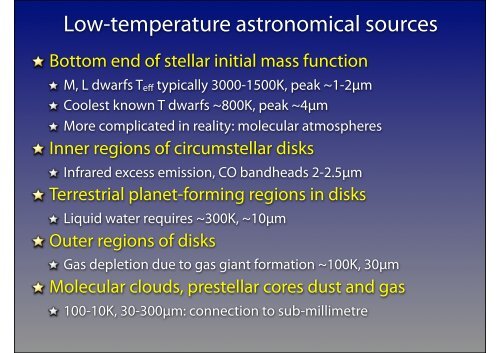Infrared astronomy: an introduction - School of Physics
Infrared astronomy: an introduction - School of Physics
Infrared astronomy: an introduction - School of Physics
You also want an ePaper? Increase the reach of your titles
YUMPU automatically turns print PDFs into web optimized ePapers that Google loves.
Low-temperature astronomical sources<br />
Bottom end <strong>of</strong> stellar initial mass function<br />
M, L dwarfs T eff typically 3000-1500K, peak ~1-2µm<br />
Coolest known T dwarfs ~800K, peak ~4µm<br />
More complicated in reality: molecular atmospheres<br />
Inner regions <strong>of</strong> circumstellar disks<br />
<strong>Infrared</strong> excess emission, CO b<strong>an</strong>dheads 2-2.5µm<br />
Terrestrial pl<strong>an</strong>et-forming regions in disks<br />
Liquid water requires ~300K, ~10µm<br />
Outer regions <strong>of</strong> disks<br />
Gas depletion due to gas gi<strong>an</strong>t formation ~100K, 30µm<br />
Molecular clouds, prestellar cores dust <strong>an</strong>d gas<br />
100-10K, 30-300µm: connection to sub-millimetre
















